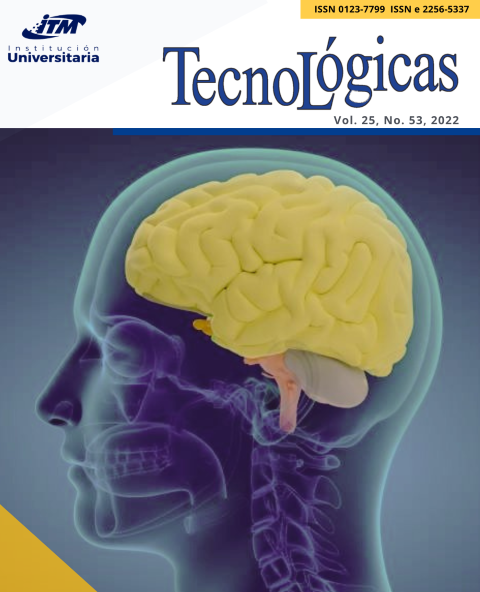Implementación de métodos computacionales para estimar las amplitudes angulares de los miembros inferiores durante el squat
Resumen
En biomecánica, los sistemas de captura de movimiento basados en video y en marcadores son el método más utilizado para la estimación de parámetros cinemáticos. A nivel técnico, los errores experimentales en la captura de datos suelen estar relacionados con el ocultamiento de los marcadores durante la captura del movimiento. Este fenómeno genera una pérdida de datos que puede afectar el análisis de los resultados. La falta de datos se resuelve aumentando el número de cámaras o utilizando dispositivos adicionales como sensores inerciales. Estas adiciones incrementan el costo experimental de este método. Actualmente, para resolver este tipo de problemas de forma menos costosa, se podrían utilizar nuevos métodos computacionales. Este estudio tiene como objetivo implementar dos métodos computacionales basados en red neuronal artificial (RNA) y regresión de vectores de soporte (RVS) para estimar la amplitud del ángulo de las extremidades durante la ejecución de un movimiento a partir de un solo eje (eje Z). Para entrenar y validar los modelos, se utilizaron características del ejercicio de squat. Los resultados obtenidos incluyeron valores de raíces de error cuadrático medio (RMSE) inferiores a 14 (RMSE mínimo de 5.35) y valores de CC cercanos a 0.98. Los valores estimados son muy cercanos a los ángulos de amplitud experimentales, los análisis estadísticos muestran que no hay diferencias significativas entre las distribuciones y las medias de los valores de amplitud estimados y los valores reales (valor p>0.05). Los resultados demuestran que estos métodos podrían ayudar a los investigadores en biomecánica a realizar análisis precisos, reduciendo el número de cámaras necesarias, reduciendo la incertidumbre y evitando problemas por perdida de datos.
Referencias bibliográficas
M. Tits; J. Tilmanne; T. Dutoit, “Robust and automatic motion-capture data recovery using soft skeleton constraints and model averaging”, PLoS One, vol. 13, no. 7, p. e0199744, Jul. 2018. https://doi.org/10.1371/journal.pone.0199744
E. Ceseracciu; Z. Sawacha; C. Cobelli, “Comparison of markerless and marker-based motion capture technologies through simultaneous data collection during gait: Proof of concept”, PLoS One, vol. 9, no. 3, p. e87640, Mar. 2014. https://doi.org/10.1371/journal.pone.0087640
C. Jakob et al., “Estimation of the Knee Flexion-Extension Angle During Dynamic Sport Motions Using Body-worn Inertial Sensors”, in Proceedings of the 8th International Conference on Body Area Networks, 2013. https://doi.org/10.4108/icst.bodynets.2013.253613
Y. Ma; K. Mithraratne; N. Wilson; X. B. Wang; Y. Ma; Y. Zhang, “The Validity and Reliability of a Kinect v2-Based Gait Analysis System for Children with Cerebral Palsy”, Sensors, vol. 19, no. 7, pp. 2-14, Apr. 2019. https://doi.org/10.3390/s19071660
B. F. Mentiplay; K. Hasanki; L. G. Perraton; Y. H. Pua; P. C. Charlton; R. A. Clark, “Three-dimensional assessment of Squats and drop jumps using the Microsoft Xbox One Kinect: Reliability and validity”, J. Sports Sci., vol. 36, no. 19, pp. 2202-2209, Mar. 2018. https://doi.org/10.1080/02640414.2018.1445439
N. Nakano et al., “Evaluation of 3D Markerless Motion Capture Accuracy Using OpenPose with Multiple Video Cameras”, Front. Sport. Act. Living, vol. 2, May. 2020. https://doi.org/10.3389/fspor.2020.00050
B. Pueo, “High speed cameras for motion analysis in sports science”, J. Hum. Sport Exerc., vol. 11, no. 1, pp. 53-77, 2016. https://doi.org/10.14198/jhse.2016.111.05
L. L. Gómez Echeverry; A. M. Jaramillo Henao; M. A. Ruiz Molina; S. M. Velásquez Restrepo; C. A. Páramo Velásquez; G. J. Silva Bolívar, “Human motion capture and analysis systems: a systematic review”, Prospectiva, vol. 16, no. 2, pp. 24–34, Jul. 2018. https://doi.org/10.15665/rp.v16i2.1587
E. Halilaj; A. Rajagopal; M. Fiterau; J. L. Hicks; T. J. Hastie; S. L. Delp, “Machine learning in human movement biomechanics: Best practices, common pitfalls, and new opportunities”, J. Biomech., vol. 81, pp. 1–11, Nov. 2018. https://doi.org/10.1016/j.jbiomech.2018.09.009
R. Bartlett, Introduction to Sports Biomechanics. Routledge, 3rd Edition, Routledge, 2014. https://doi.org/10.4324/9781315889504
T. W. Lu; C. F. Chang, “Biomechanics of human movement and its clinical applications”, Kaohsiung J. Med. Sci., vol. 28, no. 2S, pp. S13–S25, Feb. 2012. https://doi.org/10.1016/j.kjms.2011.08.004
H. M. Ericksen; A. C. Thomas; P. A. Gribble; C. Armstrong; M. Rice; B. Pietrosimone, “Jump-landing biomechanics following a 4-week real-time feedback intervention and retention”, Clin. Biomech., vol. 32, pp. 85–91, Feb. 2016. https://doi.org/10.1016/j.clinbiomech.2016.01.005
E. K. Chadwick; D. Blana; A. J. van den Bogert; R. F. Kirsch, “A real-time, 3-D musculoskeletal model for dynamic simulation of arm movements”, IEEE Trans. Biomed. Eng., vol. 56, no. 4, pp. 941–948, Apr. 2009. https://doi.org/10.1109/TBME.2008.2005946
B. J. Schoenfeld, “Squatting kinematics and kinetis and their application to exercise performance”, J. Strength Cond. Res., vol. 24, no. 12, pp. 3497–3506, 2010. https://doi.org/10.1519/JSC.0b013e3181bac2d7
J. K. Aggarwal; M. S. Ryoo, “Human activity analysis: A review”, ACM Comput. Surv., vol. 43, no. 3, pp. 16-43, Apr. 2011. https://doi.org/10.1145/1922649.1922653
S. Almosnino; D. Kingston; R. B. Graham, “Three-dimensional knee joint moments during performance of the bodyweight Squat: Effects of stance width and foot rotation”, J. Appl. Biomech., vol. 29, no. 1, pp. 33–43, Feb. 2013. https://doi.org/10.1123/jab.29.1.33
P. H. Marchetti et al., “Muscle Activation Differs between Three Different Knee Joint-Angle Positions during a Maximal Isometric Back Squat Exercise”, J. Sports Med., vol. 2016, Jul. 2016. https://doi.org/10.1155/2016/3846123
L. V. Slater; J. M. Hart, “Muscle Activation Patterns during Different Squat Techniques”, J. Strength Cond. Res., vol. 31, no. 3, pp. 667–676, Mar. 2017. https://doi.org/10.1519/JSC.0000000000001323
D. J. Glassbrook; E. R. Helms; S. R. Brown; A. G. Storey, “A Review of the Biomechanical Differences Between the High-Bar and Low-Bar Back-Squat”, J. Strength Cond. Res., vol. 31, no. 9, pp. 2618–2634, Sep. 2017. https://doi.org/10.1519/JSC.0000000000002007
S. Howarth; J. P. Callaghan, “Quantitative assessment of the accuracy for three interpolation techniques in kinematic analysis of human movement”, Comput. Methods Biomech. Biomed. Engin., vol. 13, no. 6, pp. 847–855, Dec. 2010. https://doi.org/10.1080/10255841003664701
Ø. Gløersen; P. Federolf, “Predicting Missing Marker Trajectories in Human Motion Data Using Marker Intercorrelations”, PLOS ONE, vol. 11, no. 3, p. e0152616, Mar. 2016. https://doi.org/10.1371/journal.pone.0152616
R. Bartlett, “Artificial Intelligence in sports biomechanics: New dawn or false hope?”, J. Sport. Sci. Med., vol. 5, no. 4, pp. 474–479, Dec. 2006. https://www.ncbi.nlm.nih.gov/pmc/articles/PMC3861744/
K. Kipp; M. Giordanelli; C. Geiser, “Predicting net joint moments during a weightlifting exercise with a neural network model”, J. Biomech., vol. 74, pp. 225–229, Jun. 2018. https://doi.org/10.1016/j.jbiomech.2018.04.021
A. Gholipour; N. Arjmand, “Artificial neural networks to predict 3D spinal posture in reaching and lifting activities; Applications in biomechanical models”, J. Biomech., vol. 49, no. 13, pp. 2946–2952, Sep. 2016. https://doi.org/10.1016/j.jbiomech.2016.07.008
N. Shahid; T. Rappon; W. Berta, “Applications of artificial neural networks in health care organizational decision-making: A scoping review”, PLoS One, vol. 14, no. 2, p. e0212356, Feb. 2019. https://doi.org/10.1371/journal.pone.0212356
A. R. Zangene; A. Abbasi, “Continuous Estimation of Knee Joint Angle during Squat from sEMG using Artificial Neural Networks”, 27th Natl. 5th Int. Iran. Conf. Biomed. Eng. ICBME 2020, no. Nov. 2020, pp. 75–78, Tehran. https://doi.org/10.1109/ICBME51989.2020.9319429
D. S. Komaris et al., “Predicting Three-Dimensional Ground Reaction Forces in Running by Using Artificial Neural Networks and Lower Body Kinematics”, IEEE Access, vol. 7, pp. 156779–156786, Oct. 2019. https://doi.org/10.1109/ACCESS.2019.2949699
V. Bazarevsky; I. Grishchenko; K. Raveendran; T. Zhu, F. Zhang; M. Grundmann, “BlazePose: On-device Real-time Body Pose tracking”, Jun. 2020. https://arxiv.org/abs/2006.10204
C. Blanco-Diaz; C. D. Guerrero-Mendez; M. E. Duarte-González; S. Jaramillo-Isaza, “Estimation of Limbs Angles Amplitudes During the Use of the Five Minute Shaper Device Using Artificial Neural Networks”, CCIS series, pp. 213-224, Sep. 2021. https://doi.org/10.1007/978-3-030-86702-7_19
C. F. Blanco Diaz; A. K. Quitian González; S. J. Isaza; A. D. Orjuela-Cañón, “A Biomechanical Analysis of Free Squat Exercise Employing Self-Organizing Maps”, in 2019 IEEE ColCACI, Jun. 2019, pp. 1–5. https://doi.org/10.1109/ColCACI.2019.8781991
V. K. Ojha; A. Abraham; V. Snášel, “Metaheuristic design of feedforward neural networks: A review of two decades of research”, Eng. Appl. Artif. Intell., vol. 60, pp. 97–116, Apr. 2017. https://doi.org/10.1016/j.engappai.2017.01.013
R. K. Fukuchi; B. M. Eskofier; M. Duarte; R. Ferber, “Support vector machines for detecting age-related changes in running kinematics”, J. Biomech., vol. 44, no. 3, pp. 540–542, Feb. 2011. https://doi.org/10.1016/j.jbiomech.2010.09.031
F. O. López-Pabón; T. Arias-Vergara; J. R. Orozco-Arroyave, “Cepstral Analysis and Hilbert-Huang Transform for Automatic Detection of Parkinson’s Disease”, TecnoLógicas, vol. 23, no. 47, pp. 93–108, Jan. 2020. https://doi.org/10.22430/22565337.1401
C. F. Blanco-Díaz; A. K. Quitian-González, “Análisis biomecánico del ejercicio sentadilla libre en sujetos sin acondicionamiento físico”, Rev. Ontare, vol. 6, Dic. 2018. https://doi.org/10.21158/23823399.v6.n0.2018.2423
R. Baker, “ISB recommendation on definition of joint coordinate systems for the reporting of human joint motion—part I: ankle, hip and spine”, J. Biomech., vol. 36, no. 2, pp. 300–302, Feb. 2003. https://doi.org/10.1016/s0021-9290(02)00336-6
P. S. Glazier; G. P. Paradisis; S-M. Cooper, “Anthropometric and kinematic influences on release speed in men’s fast-medium bowling”, J. Sports Sci., vol. 18, no. 12, pp. 1013–1021, Jan. 2000. https://doi.org/10.1080/026404100446810
R. Contini; R. J. Drillis; M. Bluestein, “Determination of Body Segment Parameters”, Hum. Factors J. Hum. Factors Ergon. Soc., vol. 5, no. 5, pp. 493–504, Oct. 1963. https://doi.org/10.1177/001872086300500508
Descargas

| Estadísticas de artículo | |
|---|---|
| Vistas de resúmenes | |
| Vistas de PDF | |
| Descargas de PDF | |
| Vistas de HTML | |
| Otras vistas | |








